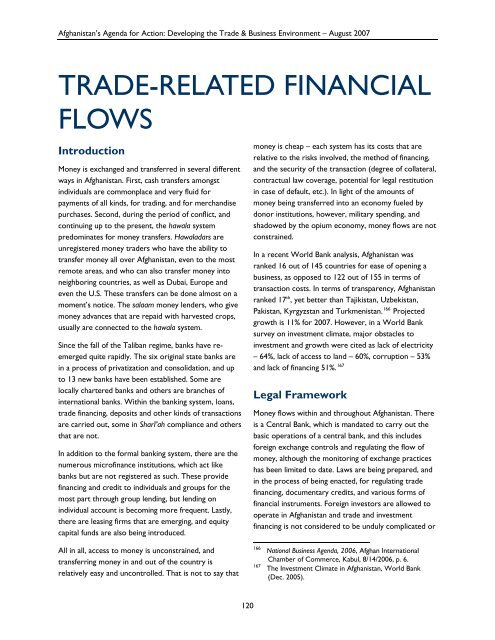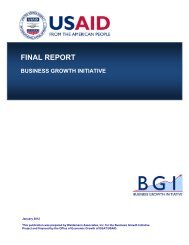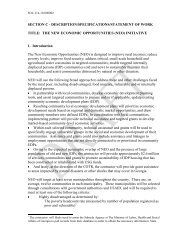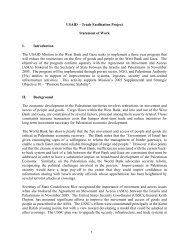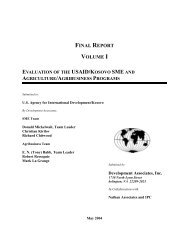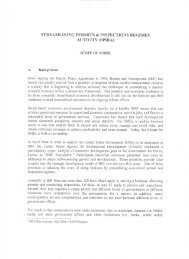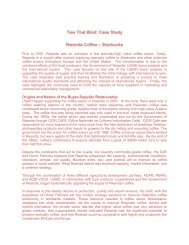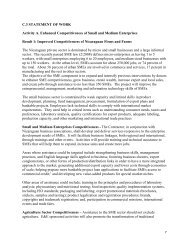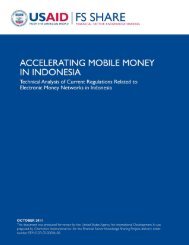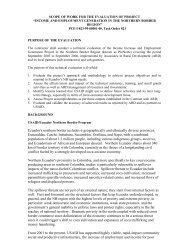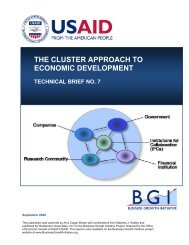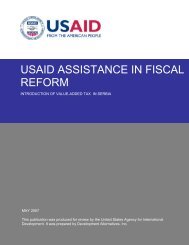Afghanistan's Agenda for Action - Economic Growth - usaid
Afghanistan's Agenda for Action - Economic Growth - usaid
Afghanistan's Agenda for Action - Economic Growth - usaid
You also want an ePaper? Increase the reach of your titles
YUMPU automatically turns print PDFs into web optimized ePapers that Google loves.
Afghanistan’s <strong>Agenda</strong> <strong>for</strong> <strong>Action</strong>: Developing the Trade & Business Environment – August 2007TRADE-RELATED FINANCIALFLOWSIntroductionMoney is exchanged and transferred in several differentways in Afghanistan. First, cash transfers amongstindividuals are commonplace and very fluid <strong>for</strong>payments of all kinds, <strong>for</strong> trading, and <strong>for</strong> merchandisepurchases. Second, during the period of conflict, andcontinuing up to the present, the hawala systempredominates <strong>for</strong> money transfers. Hawaladars areunregistered money traders who have the ability totransfer money all over Afghanistan, even to the mostremote areas, and who can also transfer money intoneighboring countries, as well as Dubai, Europe andeven the U.S. These transfers can be done almost on amoment’s notice. The salaam money lenders, who givemoney advances that are repaid with harvested crops,usually are connected to the hawala system.Since the fall of the Taliban regime, banks have reemergedquite rapidly. The six original state banks arein a process of privatization and consolidation, and upto 13 new banks have been established. Some arelocally chartered banks and others are branches ofinternational banks. Within the banking system, loans,trade financing, deposits and other kinds of transactionsare carried out, some in Sharī’ah compliance and othersthat are not.In addition to the <strong>for</strong>mal banking system, there are thenumerous microfinance institutions, which act likebanks but are not registered as such. These providefinancing and credit to individuals and groups <strong>for</strong> themost part through group lending, but lending onindividual account is becoming more frequent. Lastly,there are leasing firms that are emerging, and equitycapital funds are also being introduced.money is cheap – each system has its costs that arerelative to the risks involved, the method of financing,and the security of the transaction (degree of collateral,contractual law coverage, potential <strong>for</strong> legal restitutionin case of default, etc.). In light of the amounts ofmoney being transferred into an economy fueled bydonor institutions, however, military spending, andshadowed by the opium economy, money flows are notconstrained.In a recent World Bank analysis, Afghanistan wasranked 16 out of 145 countries <strong>for</strong> ease of opening abusiness, as opposed to 122 out of 155 in terms oftransaction costs. In terms of transparency, Afghanistanranked 17 th , yet better than Tajikistan, Uzbekistan,Pakistan, Kyrgyzstan and Turkmenistan. 166 Projectedgrowth is 11% <strong>for</strong> 2007. However, in a World Banksurvey on investment climate, major obstacles toinvestment and growth were cited as lack of electricity– 64%, lack of access to land – 60%, corruption – 53%and lack of financing 51%. 167Legal FrameworkMoney flows within and throughout Afghanistan. Thereis a Central Bank, which is mandated to carry out thebasic operations of a central bank, and this includes<strong>for</strong>eign exchange controls and regulating the flow ofmoney, although the monitoring of exchange practiceshas been limited to date. Laws are being prepared, andin the process of being enacted, <strong>for</strong> regulating tradefinancing, documentary credits, and various <strong>for</strong>ms offinancial instruments. Foreign investors are allowed tooperate in Afghanistan and trade and investmentfinancing is not considered to be unduly complicated orAll in all, access to money is unconstrained, andtransferring money in and out of the country isrelatively easy and uncontrolled. That is not to say that166167National Business <strong>Agenda</strong>, 2006, Afghan InternationalChamber of Commerce, Kabul, 8/14/2006, p. 6.The Investment Climate in Afghanistan, World Bank(Dec. 2005).120


